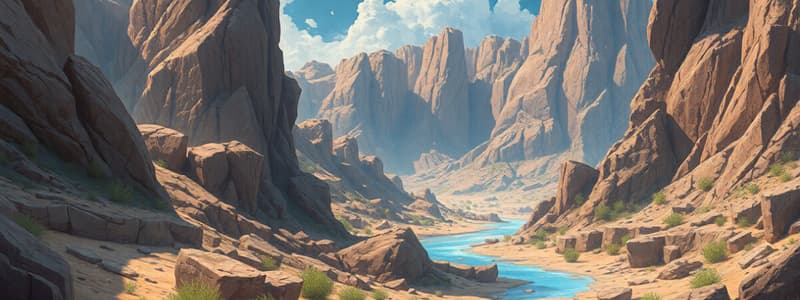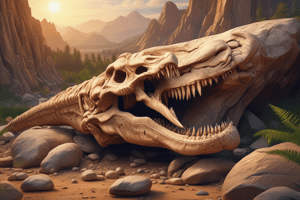Podcast
Questions and Answers
Which type of fossil represents evidence of animal activity?
Which type of fossil represents evidence of animal activity?
- Coprolite
- Trace fossil (correct)
- Amber fossil
- Body fossil
What is the primary requirement for remains to be classified as fossils?
What is the primary requirement for remains to be classified as fossils?
- They must be over 10,000 years old. (correct)
- They must include entire body structures.
- They must be preserved in amber.
- They must be found in sedimentary rocks.
In which type of rock are most fossils found?
In which type of rock are most fossils found?
- Metamorphic rock
- Volcanic rock
- Igneous rock
- Sedimentary rock (correct)
What does the term 'coprolite' refer to?
What does the term 'coprolite' refer to?
What commonly accompanies plant or animal fossils in sedimentary rock?
What commonly accompanies plant or animal fossils in sedimentary rock?
Which feature primarily distinguishes amber fossils from other types?
Which feature primarily distinguishes amber fossils from other types?
Where can significant fossil findings typically be located?
Where can significant fossil findings typically be located?
Which mineralized fossil typically represents the external shape and structural features of the original plant or animal?
Which mineralized fossil typically represents the external shape and structural features of the original plant or animal?
What is the significance of sedimentary rocks that are 67 million years old?
What is the significance of sedimentary rocks that are 67 million years old?
What process contributes to the formation of a body fossil?
What process contributes to the formation of a body fossil?
Flashcards
Body Fossil
Body Fossil
Fossils formed from the preserved remains of plants or animals trapped and hardened under sediment.
Trace Fossil
Trace Fossil
Fossils formed from traces of animal activity, like footprints or burrows, preserved in hardened sediment.
Sedimentary Rock
Sedimentary Rock
Rocks formed from layers of sediment that have compressed and hardened over time.
Amber Fossil
Amber Fossil
Signup and view all the flashcards
Coprolite
Coprolite
Signup and view all the flashcards
Fossil Mold
Fossil Mold
Signup and view all the flashcards
Fossil Cast
Fossil Cast
Signup and view all the flashcards
Fossil Formation
Fossil Formation
Signup and view all the flashcards
Paleontology
Paleontology
Signup and view all the flashcards
Fossil Location
Fossil Location
Signup and view all the flashcards
Study Notes
Fossil Types
- Fossils are the preserved remains or traces of ancient life, typically over 10,000 years old.
- Trace fossils: Evidence of animal activity/behavior preserved, like footprints.
- Body fossils: Remains of plants or animals preserved, often replaced by minerals.
- Dinosaur fossils are a prime example.
Types of Rocks for Fossils
- Sedimentary rocks: Most common for fossil discovery. Formed from compressed sediment (sand, silt, clay).
- Examples include limestone and sandstone.
- Process: Plants/animals get buried by sediment; minerals replace the original material; the organism dissolves leaving a mold.
- The fossil itself is not the original organism but a mineral cast/mold.
- Fossil age helps pinpoint organism life time. (Ex: Tyrannosaurus Rex – 67 million years old)
Amber Fossils
- Amber fossils: Rare fossils found in amber, a preserved tree resin with trapped organisms.
- Most amber fossils contain insects, preserved in the hardening resin.
Fossil Locations
- High desert regions: Often good for fossil discovery due to less organic matter.
- Western United States, Argentina, and China: Locations with fossil discoveries.
Fossil Poop (Coprolites)
- Coprolites: Fossil poop, valuable in identifying ancient organisms.
- Used to determine diet and species.
- Found in diverse animals, like dinosaurs, fish, crocodiles, and insects.
- Example: Coprolites from 50 million-year-old fish found in Wyoming; Crocodile coprolites in South Carolina
Studying That Suits You
Use AI to generate personalized quizzes and flashcards to suit your learning preferences.




